#chinatea
Explore tagged Tumblr posts
Text
ChinaTea: Celebrating 75 Years of Commitment to National Service and Pioneering Innovation in Tea Technology
Tea, a quintessential part of China’s heritage, is celebrated not only for its rich flavors but also as one of the healthiest beverages worldwide. As modern life becomes increasingly demanding, consumers are placing greater emphasis on health and well-being, sparking a growing interest in tea. According to a representative from ChinaTea Company (referred to as “ChinaTea”), the tea industry uniquely blends health benefits with cultural significance, signaling a promising future.
A New Chapter in China’s Tea Industry
Founded in 1949 with the backing of the Central Financial Committee, ChinaTea was first managed by Wu Juenong, who later earned the title of “Contemporary Tea Sage.” As one of the earliest national enterprises in the post-revolution trade system, ChinaTea centralized the procurement, processing, export, and domestic sale of tea, playing a vital role in generating foreign exchange for the nation and laying the groundwork for the revitalization of China’s tea sector.

Now, 75 years later, ChinaTea boasts a comprehensive portfolio encompassing six traditional tea varieties: green, yellow, white, oolong, black, and dark tea, along with flower teas. The company oversees 220,000 acres of tea gardens across provinces like Fujian, Yunnan, and Guangxi, supported by two raw material centers and 18 processing facilities. Its extensive online and offline sales network includes over 2,500 retail locations in key tea-producing regions.
Recently, ChinaTea has been recognized as the leading company in the “2023 Comprehensive Strength of Top 100 Tea Enterprises,” demonstrating its dominant position in the market, where it procures an impressive 25,000 tons of tea, significantly benefiting local economies and increasing farmers’ incomes.
Innovation Meets Tradition
The tea industry is not just an agricultural staple; it is a cornerstone for promoting economic development and revitalizing rural areas. By merging traditional culture with modern economic practices, the tea sector drives growth through optimized production techniques and enhanced product value. Additionally, it plays a crucial role in elevating farmers’ incomes, improving rural infrastructure, and promoting sustainable agriculture, making it a vital force in rural revitalization.
ChinaTea has historically nurtured some of the foremost experts in the field, such as Wu Juenong and Huang Guoguang, solidifying its status as a leader in modern Chinese tea technology. In the current era, the company has ramped up efforts to cultivate talent, training successors in traditional tea-making skills while also supporting numerous recipients of State Council special allowances.
Since the 1950s, ChinaTea has pioneered various processing technologies, such as white tea withering methods and ripe Pu-erh tea production techniques, which are now industry standards. The company has established a technical committee dedicated to promoting innovations like the rapid aging process of Liu Bao tea and the smart withering system for Dian Hong tea. By integrating cutting-edge technology — including IoT for smart tea gardens and big data for 5G logistics — ChinaTea enhances the efficiency and effectiveness of tea production.
ChinaTea also actively contributes to the establishment of national and industry standards, helping to ensure product quality that consistently exceeds regulatory requirements, thus setting the bar for the entire sector.
Transforming Resources into Quality Products
Tea production in China spans diverse climate zones, and the unique growing conditions often yield high-quality tea from seemingly poor soils. The ancient sage Lu Yu once remarked, “Good tea grows from poor soil,” highlighting that tea plants thrive in rocky, loose soils that do not compete with staple crops. This characteristic positions the tea industry as a crucial player in China’s rural revitalization efforts.
Each tea leaf not only enriches local farmers but also contributes to a broader narrative of rural renewal. As a leading force in the tea sector, ChinaTea harnesses its technological capabilities to provide farmers with the tools needed to escape poverty. During the 14th Five-Year Plan, the company formed a team of technology specialists focused on integrating the “Three Teas” with rural development, training over 3,000 local officials in tea cultivation practices.
“Show farmers how it’s done, guide them in their efforts, and help them thrive,” is the mantra at ChinaTea. The company is continuously innovating ways to leverage the tea industry for rural revitalization, establishing a model that combines industry growth, brand enhancement, and technological progress. In partnership with two states and 14 counties, ChinaTea has launched over 60 varieties of “ChinaTea + Specialty Quality Tea” products, building a diverse “Shanshui ChinaTea” product line. By deploying technology teams, the company ensures that scientific advancements translate into real-world benefits, turning “green mountains and clear waters” into “golden mountains and silver mountains.”
1 note
·
View note
Text
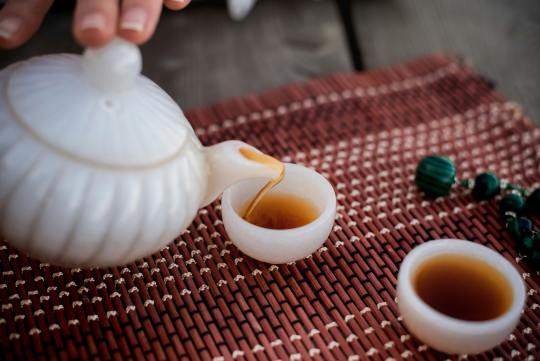
Chinese Tea
#londontea#greentea#chaitea#herbtea#teadrink#icedtea#oolongtea#drinktea#hightea#tealovers#chinese#chinatea#tea#chinesetea#taiwantea#herbaltea#teaworld#teabreak#teaculture#rawtea#teabrick#yunnantea#tealife#organictea#teareview#igtea#afternoontea#teaquote#teaservice#teajournal
0 notes
Note
I recently acknowledged about the persona aus and nobody is as desperate to read them as me. Saddens me so much that it was all there but i just got into kpop that time. Is there any way to read them? You are the only one I saw active about it
Hi anon, thanks for your message-
Unfortunately I don't have a super easy solution for you or single place you can read everything. One day I hope this blog can be a central place for personas content, but until then here are some things you can try:
Wayback machine on satellite-jeon's old blog url (click on URLs and search for "post", then you can click into the different listings, though keep in mind this includes non-personas content as well)
Enter each individual link from chinatea's personas master list into wayback machine (since most posts on the list has disappeared from being hosted on satellite-jeon's blog)
Trawl the personas au tag on tumblr for both the posts in it and contributors who might have reblogged content whose original post(er) was deleted
You could also try searching for some of the tags on this blog on all of tumblr (ymmv if they've been used for other things tho)
Look through the notes of any posts you find and check blogs who have reblogged personas content to see what else you can find on their blogs (preferably with tags so you can just filter for personas stuff)
These are the main avenues I've been using to find old posts to re-blog here, sorry I can't be of more help!
9 notes
·
View notes
Photo

青花和茶 #chinatea #chinateacup #oolong(在 Yu Garden) https://www.instagram.com/p/CojFYA-yAHW/?igshid=NGJjMDIxMWI=
19 notes
·
View notes
Text
What is White Tea?

What is white tea???
The everyday tea drinker likely has heard of and drinks black and green teas. Two of the most common types of tea in North American, not counting herbal (which isn’t really tea). And while there are certainly a fair numbers of tea drinkers in this part of the world that have heard of white tea, I still meet people almost daily, who have never heard of it. For many, white tea is an odd name they may come across in the tea section of your grocery store, or in your local loose tea retailer. I find oolong also falls under this category. But even so, for those of you who may not know, let’s take a dive into the sweet and subtle world of white tea.
White tea is most commonly grown in Fuding in the Fujian province of China. However, it is also grown in Taiwan and in recent years in India, Sri Lanka, Thailand, and Nepal. But for now, we’ll focus on the most commonly found and sold white teas which hail from China.
Harvest & Processing
The white tea we know in present day, without going into great detail on history, was first commercially produced in the 1700’s, although it predates this period. These teas are made using large leaf varietals of the Camellia Sinensis plant from which all true tea derives. Now a days, white teas come from the Camellia Assamica varietal while in the past it was harvested from the Camellia Taliensis varietal. This varietal has however, become endangered due to over picking. It is still possible to find white teas made from this varietal.
White tea goes through the least amount of processing out of all the 6 types of tea. It goes through very little oxidization unlike other tea types which range from medium to high oxidization. After the leaves are harvested, they go through the process of withering and then drying. The drying process is usually done in the same manner as puerh, which is sun drying, but is also quite often done indoors to control the environment.
Types
The two most famous types of white tea found on the market are Bai Hao Yin Zen (Silver Needle) and Bi Mudan (White Peony). In addition, there are two other grades of white tea that have also become quite popular, especially amongst people who like to age white tea, Gong Mei and Shou Mei.
Besides these types, there are other “odd ball” white teas from China can be found but are not nearly as common or popular.
Bai Hao Yin Zen (Silver Needle)

Silver Needle is the most prized and expensive type of white tea, as it is made using only young leaf buds. The buds are easily recognizable by their silver color and covered with white, silvery hairs also referred to as downy. These hairs or downy are a good sign of high quality Silver Needle. These are young tender buds that are picked before they are able to open up.
Silver Needle is recognized as one of the Top 10 Teas of China
Silver Needle has a very distinct flavor that is very light and mellow and can be described as sweet, vegetal and delicate. I often find them to have floral notes and a honey like sweetness.
When brewing Silver Needle, it is usually best to use a lower temperature using a slightly higher ratio of tea for a longer infusion for western brewing. Usually around 3-5 minutes. For gongfu brewing, a lower temperature water is also generally used, with infusions of around 15-30 seconds depending on the brewer's taste. I myself have experimented with silver Needle using gongfu methods and have found good results using full boiling water with quicker infusions of 5-10 seconds.
I also tend to like my Silver Needle done “grandpa style” with putting my leaves in a pot or glass loose with boiling water and allowing them to just sit and steep. I find this brings out a fuller body and an almost fruity like quality, but this is just to my taste.
I also recommend using glass teawares for brewing Silver Needle. The reason for this based on the benefits of glass teaware for delicate teas (see my older post of vessel materials) and also to appreciate the pale yellow color of the tea as the little silver hairs float around the cup.
Bi Mudan (White Peony)

This type of white tea is made using the common picking ratio of one bud and two leaves. The taste of White peony can be described as being similar to Silver Needle, but with a fuller body and greater potency. It also has a similar appearance to Silver Needle with the presence of downy silver buds, with the addition of light green leaves. For lower grade, the leaves may appear to be a dark green or a mixture of green and brown leaves.
Because the tea has the addition of these young leaves, the tea does not need to brew as long as Silver Needle. I usually steep mine for 2-4 minutes western style with a lower temperature water. However, like Silver Needle, I have found that it brews well using boiling water when done gongfu. Very quick flash infusions (5 seconds or less) pull out a light, fruity and leafy flavor without becoming bitter. Using the gongfu method, I find I can get between 8-10 infusions using high temperature water before the tea begins to lose flavor.
Gong Mei & Shou Mei (Tribute Eyebrow & Longevity Eyebrow)

Gong Mei is regarded as a 3rd grade tea.

While Shou Mei is a 4th grade.
These types of white tea are harvested later than White Peony and Silver Needle. Because of this, these teas have a much stronger, more potent flavor and darker in color. Like Peony, these teas both consist of leaves and buds, however the main difference between the two the greater number of buds found in Gong Mei compared to Shou Mei (Gong Mei - 1 bud, 2-3 leaves, Shou Mei - 1 bud, -leaves). In addition, the leaves of the tea usually range from golden brown, reddish or black, or a mixture.
These types of white tea are also quite forgiving of higher temperature water when brewing and are commonly brewed using boiling water. A very popular method to brew Gong Mei and Shou Mei is to begin using a gongfu method. After around the 6th infusion when the flavor beings to fade, transfer the leaves to a pot or kettle and bring up to a boil for up to 5-6 minutes.
Yue Guang Bai (Moonlight White)

Odd name right?
Well, the name comes with a reason. The main difference between this tea and other white teas, is Moonlight White is harvested at NIGHT. This is due to the tea being a C3, which stores carbohydrates during a cycle of darkness. Because of this, when picked at night, the leaves have a higher concentrate of sugar, making the teas sweet to drink. In addition to this, unlike other white teas, this tea is traditionally dried at night by moonlight as opposed to sun drying during the day. It can also be dried indoors at night as well.
Another difference in this tea is while other are grown in Fujian, this tea is grown in Yunnan.
The tea can be recognized by its mixture of bright silvery downy buds mixed with dark, almost black leaves.
Brewing Moonlight White is generally best gongfu style in very similar fashion to Peony or Gong Mei.
Aging

In recent years, the practice of aging white tea has become popular. This is done much in the same fashion as with puerh. White teas are pressed into cakes and then dry stored for a prolonged period of time. This is said to enhance the flavor of the teas, further bring out its natural sweetness and rids the tea of any unwanted bitterness. Aged white teas, like puerh, can come at a moderate to high price. Mostly Gong Mei and Shou Mei teas are pressed and aged but Silver Needle, Moonlight White and Peony can also be found pressed and aged.
#white#whotetea#fujian#teatlr#fuding#china#chinatea#tea#loosetea#whitetea#loosewhitetea#gongmei#silver#silverneedle#shoumei#eyebrow#yunnan#teacake#aged#agedte#moonlight#sundries#moonlightwhite#penoy#whitepeony
22 notes
·
View notes
Text

Chung King road. (Day)🏮🏮🏮🥮🏮
#chinatown#chinatea#chung king road#socal#los angeles#hollywood#dumplings#dim sum#red bean#lotus seeds#lantern festival#chinese lantern#lanterns#lantern#art gallery#travel photography#travel blog#travel diary#chinese food#cityscape#city photography#day photography#california love#travel journal#mandarin#kungfu#martial arts#kung fu films#rush hour#jackie chan
3 notes
·
View notes
Note
Questions 3, 4, 6, 11, 16, 19, please. (I tried not to be too greedy, but...)
😭😭 you’re not being too greedy, thank you for sending it through .���̣̇.ಇ/ᐠˬ ͜ ˬ ᐟ\∫.₊̣̇.
3. Do you write fics from start or finish, or jump around?
Generally, I write from start to finish but jump around if it makes sense. I say I write towards a finish but ‘finish’ is usually an unknown, i.e. I don’t know where my writing might take me. If I hit a roadblock I skip and move on to another part and then sometimes go back.
4. Do you outline before you start writing? If so, how far do you stray from that outline?
No outline, we die like men. I never really plan what I write, I let new ideas and the flow of the story lead me. However, most of the time the reason I write is that I am struck with an idea or a line I want to use and structure my story around it. So the only outlining is that singular idea/line that the story is based on. That means it’s hard to tell if it really strays from the outline because it wasn’t something concrete.
6. If you’re really concentrating, how many words can you write in a day?
Oh heckkkkk, uhhhh that’s really hard to say? I think....maybe 500+ ? It’s not much
11. If you could only write angst, fluff, or smut for the rest of your life, which would it be?
Fluff. Fluff all the way.
16. What is your most underrated fic?
asdfghjk; if we measure things by hits then it’s a vmin oneshot called ‘One Look From You’ (maybe it was too short, too lacking in fulfillment with the vague waffling)
19. Who is the easiest/hardest character for you to write about? Why?
The easiest to write is Jungkook, because let’s face it, we’re all a little in love with Jimin in some way or form. It’s easy to write as him being smitten and moonstruck by Park Jimin and I love writing his shier and sensitive side.
Behind the Scenes of Fic Writing: 30 Questions for Authors
#answered#askbox answered#this was quite fun to do!#i think i ramble too much in my answer#sorry ><#chinatea
2 notes
·
View notes
Photo

❤❤❤ Have Another Cuppa on Us ❤❤❤ Experience the best today, save on worldwide shipping ❤ https://elephantchateau.com/ Try other 🏆Award Winning🏆 Delicious Teas & Spices: ❤☕ Extra Special Black Tea ❤ https://elephantchateau.com/products/ectea2/ceylon-black-tea-extra-special ❤☕ Flowery Mountain Ceylon Tea ❤ https://elephantchateau.com/products/ectea7/flowery-ceylon-black-tea-nuwara-eliya-mountain ❤☕ Royal Cinnamon Tea ❤ https://elephantchateau.com/products/ectea1/royal-ceylon-cinnamon-tea ❤☕ Royal Earl Grey Tea ❤ https://elephantchateau.com/products/ectea11/royal-earl-grey-tea-blue-flower ❤☕ Spicy Chai Tea ❤ https://elephantchateau.com/products/ectea12/ceylon-masala-spice-chai-tea ❤🔥 Fresh Organic Vanilla Beans ❤ https://elephantchateau.com/products/ecspice3/organic-vanilla-beans-grade-a-gourmet-extra-large ❤🔥 Fresh Green Cardamom ❤ https://elephantchateau.com/products/ecspice2/ceylon-green-cardamom-pods ❤🔥 Fresh Ceylon Cinnamon Quills ❤ https://elephantchateau.com/products/ecspice1/ceylon-cinnamon-quills #teatime #teaaddict #teadrinker #turkish #teaforlife #instatea #teaenthusiast #tealover #lovetea #blacktea #greentea #whitetea #oolongtea #puertea #chinatea #ceylontea #looseleaftea #tealife #teaculture #teaphotography #Tea #Thé #Té #Tè #شاي #茶 #차 #お茶 #gaiwan #gongfucha (at Los Angeles/Hollywood California) https://www.instagram.com/p/CAEnPbBF1X1/?igshid=1nf6e97q7ox19
#teatime#teaaddict#teadrinker#turkish#teaforlife#instatea#teaenthusiast#tealover#lovetea#blacktea#greentea#whitetea#oolongtea#puertea#chinatea#ceylontea#looseleaftea#tealife#teaculture#teaphotography#tea#thé#té#tè#شاي#茶#차#お茶#gaiwan#gongfucha
1 note
·
View note
Photo

The temperature to open the second life of tea! . . . #kettle #shuihu #stove #redmud #charcoal #handmade #fire #cookingwater #brewtea #teatime #life #blacktea #oolongtea #dancong #jinjunmei #tealover #teaday #teaaddicts #chinatea #chineseart #beautiful #wonderful #teataster #teadrunk #tealog #teafamily #teablogger #tearooms #teasommelier #morimatea https://www.instagram.com/p/B4ySGpJARkv/?igshid=82dewe192n1i
#kettle#shuihu#stove#redmud#charcoal#handmade#fire#cookingwater#brewtea#teatime#life#blacktea#oolongtea#dancong#jinjunmei#tealover#teaday#teaaddicts#chinatea#chineseart#beautiful#wonderful#teataster#teadrunk#tealog#teafamily#teablogger#tearooms#teasommelier#morimatea
5 notes
·
View notes
Video
Read the full article here: https://healthyjean.com/how-do-you-drink-black-tea/
Perhaps you’ve never been a tea drinker before, but you’ve decided to give it a twirl. Or maybe you already drink standard varieties of tea, but you’d like to try black tea for a change of pace. In any case, you’re wondering how you should go about drinking this refreshing, full-bodied beverage.
To begin with, you should be aware of the fact that tea aficionados around the globe tend to make tea similarly. It is true that specific methods of tea preparation may differ from country to country and from region to region.
Favorite Methods
For example, in India, black tea is often steeped with a combination of milk and hot water. In Great Britain and the rest of the United Kingdom, tea tends to be stepped quite strong, with milk or a sweetener such as sugar or honey added to enhance the taste.
In the United States, it’s quite popular to microwave a cup of cold water to brew tea. However, it is a fact that many Americans are now opting for loose teas rather than tea bags.
What You Should Know About Black Tea
Black tea tends to vary in color from a shade of reddish-brown to black. Interestingly enough, like black tea ages, it often becomes even more flavorful. To store black tea, you should place it in a location that is ventilated well, but you don’t have to worry about the temperature of the area.
In general, black tea is formed into cakes that can be round, square, or tube-like. How black tea smells and tastes may depend mainly on the location in which it was harvested. As a result, scent and flavor may vary significantly from region to region.
Black tea is known for its therapeutic benefits. For instance, fans of black tea in China tend to have a little problem with cancer or other degenerative illnesses. They may have better overall health than non-tea drinkers.
Types of Black Tea
When thinking about buying black tea, it is essential for you to know the varieties that are available. For instance, if you’re interested in high-quality tea, you might consider Keemun. This type of tea has a strong aroma and can be consumed with or without milk and sweetener.
Another preferred type is Darjeeling, an Indian tea that is known for its delicate taste. Meanwhile, Assam is a less spicy version of Keemun, but it is also known for its rich flavor.
If you’re interested in a Chinese black tea, you might consider Lapsang Souchong, which is characterized by an unusual smoky flavor. For a Chinese tea with a little bit of a kick, try Yunnan, which offers a hint of pepper.
If you prefer a lighter tea, the Indian Nilgiri may be best. However, be aware of the fact that Nilgiri requires expert steeping to achieve the right flavor.

Drinking Black Tea in Style
If you want to drink black tea in style, you should consider indulging in it at a tea salon. Such salons are ever-present, not only in Chinese cities such as Beijing but also in Taiwan.
You should be aware of the fact that menus at tea salons tend to feature a range of items. Also, the decor can differ significantly from salon to salon.
For the people of the Orient, tea salons can be as trendy as Starbucks cafes are in the Western world. Salons tend to stay open late enough to accommodate late-night patrons.
They are also a favorite of young people. Visit a tea salon in China, and you may find dozens of different varieties of teas available.
Some of the teas may have been aged two decades or more, causing them to have an especially appealing flavor. One Pu-erh tea is more than a century old and is considered a national treasure among the Chinese.
The tea salons of the Orient may also have some different sections, each reflecting a different kind of atmosphere. For instance, one part may be considered more or less a reading room, while another is best suited for playing games. As a result of this, tea salons are classified as a destination location.
Fun Ways to Enjoy Black Tea
There are undoubtedly other entertaining ways that you can enjoy black tea. For instance, you might consider holding a tea-tasting party where you invite a group of friends to sample various black tea delicacies.
Or you can plan a meal from the country of origin of your favorite blend of black tea. In other words, the possibilities for enjoying black tea are limited only by your imagination.
Once you make black tea a regular part of your diet, you’ll quickly discover that it may be able to soothe your nerves as nothing else can.
#blacktea#drinktea#tea#healthy#blackteas#teaaddict#tealover#tealovers#lovetea#chinatea#teaholic#ilovetea#teaoftheday#teatime#BlackTeaNoSugar#Pu-erh tea#Chinese black tea#loose teas#black loose leaf tea#healthyjean
4 notes
·
View notes
Photo

#Puerh #普洱茶 #puerhtea #puerhcha #puerhsk#puerhaddict #rawpuerh #té#gushu #maocha #yunnantea #chinesetea #茶葉#tearoomshop #teashops #teagram #tealife #teastyle #teaaddics #chinatea #tefftohumluçay#teablog#teameditation #wulongtea #teawriter #teacommunity #gaiwan #wholeleaftea#looseleaftea #teahead https://www.instagram.com/p/BsUeCT0hLy0/?utm_source=ig_tumblr_share&igshid=no6q61dnri53
#puerh#普洱茶#puerhtea#puerhcha#puerhsk#puerhaddict#rawpuerh#té#gushu#maocha#yunnantea#chinesetea#茶葉#tearoomshop#teashops#teagram#tealife#teastyle#teaaddics#chinatea#tefftohumluçay#teablog#teameditation#wulongtea#teawriter#teacommunity#gaiwan#wholeleaftea#looseleaftea#teahead
3 notes
·
View notes
Photo

Pu Ehr Bio Shu Cha 2014 #puehrcha #Puehrtee #puehrtea #shucha #biotee #biotea #schwarztee #blacktea #chinatee #chinatea #berlinteashop #Teesign77 #berlintee #berlinteeladen(在 Teesign 77) https://www.instagram.com/p/CnFLkQLIg3I/?igshid=NGJjMDIxMWI=
#puehrcha#puehrtee#puehrtea#shucha#biotee#biotea#schwarztee#blacktea#chinatee#chinatea#berlinteashop#teesign77#berlintee#berlinteeladen
1 note
·
View note
Text
Puerh Storage Experiment
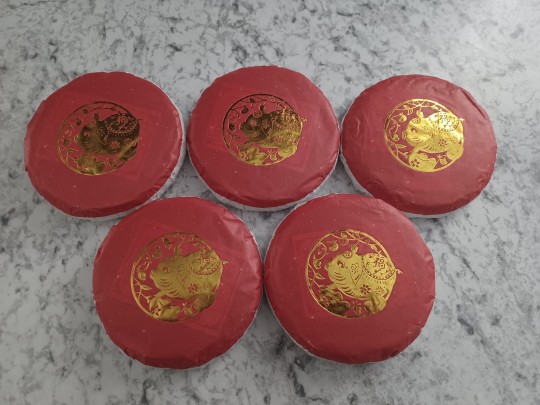
Puerh. A tea category that holds endless wonders that never cease to amaze those new to it or those who have been drinking it for years. Puerh is a tea that has two kinds of effect on people. Either it’s unique flavors and aromas scare you awy or suck you in so deep that you dare not even thing about any other kind of tea but Puerh. But to those new and those well versed in this fascinating tea, the topic of how to store and age Puerh is always up for debate. Puerh is a tea meant to be aged, and with aged comes change in the tea’s characteristics. It can lose is bitterness and become sweeter. The flavor can become smoother and richer. And the value of tea grows higher and greater, especially when aged properly. But there is the million dollar question. How do you age/ store Puerh properly?
Without going into great detail, the two main methods are “Dry Storage” and “Wet Storage”. These names refer to two different methods where both temperature and humidity are controlled to allow for the desired outcome. Puerh that has been wet stored ages faster while Puerh dry stored ages slower. However if is worth mentioning that while these are the two most commonly discussed ways of aging Puerh, they hold little no value outside of China where these methods originate. Why? Because these methods were created naturally based on areas of China where Puerh is stored that either have naturally dry weather or naturally humid weather. But what about the rest of the world?
I live it Canada. Here outside of summer the weather tends to be on the dryer and cooler side. This is very different from the weather in China. Puerh is drank by people all over the world, yet we only discuss aging and storage methods used in China. All parts of the world have different weather conditions and therefore have different challenges in this field. And while your intention may not be to age your Puerh, weather and temperature in your location could also make all the difference when it comes to simply storing your Puerh so it stay fresh and maintains the characteristics you like. And so I finally decided to do an experiment.
I purchased 5 100g Puerh cakes from Yunnan Sourcing. All 5 far are the same cake consisting of raw Puerh from 2019. In this experiment my intention is not only test how naturally Canadian weather affects Puerh storage through a few different methods, but also to see how best to store your Puerh if you don’t want it to age, but want to maintain and save it’s characteristics that make you love it. In this experiment I am using storage methods that easily suit the everyday person. Yes, expensive humidors used for cigars and tobacco can be used to recreate wet and dry storage methods, but a humidors big enough to house all your Puerh cakes is not likely int he budget. This experiment is broken down into three parts. Part 1 is has to due with whole cakes. Part 2 has to due with broken cakes. And finally part 3 has to do with mao cha (loose Puerh). So let’s take a close up look at the experiments:
#1 - Whole Cake Aging & Storage
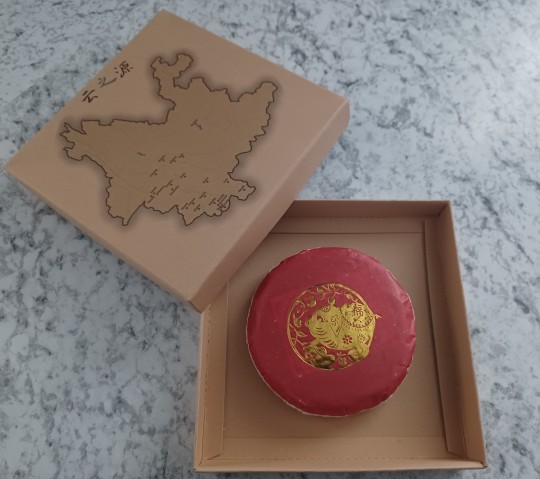
Puerh has been pressed into may shapes, in many sizes throughout history, mostly for the purpose of easy storage and transportation. But how does being pressed into a cake or brick affect the tea’s ability to age? It is said that while the outer part of the cake slowly oxidizes inward from being exposed to oxygen, the cake also ferments slowly from the inside outward. This is due to a small amount of moisture that gets trapped inside during the steaming and pressing process. And so part one of this experiment will focus on storing whole unbroken cakes.
Cake #1 will be stored in it’s original wrapper and kept inside a cardboard box to help filter out any unwanted aromas as well as light. The box will also allow for some oxygen flow without being fully exposed to the outside elements. The purpose here is to see how the tea ages with controlled oxygen and minimal outside exposure.
Cake #2 also is being stored in it’s original wrapper, but is also being put into a sealed zip lock bag with all the air pressed out. It too will then be stored in a cardboard box. The purpose here is to see if by eliminating all contact to oxygen if we can protect and savior the current characteristics of the cake. The point being to prevent aging and maintain its current character, for those who like myself, may not want to age their Puerh but simply preserve it.
#2 - Broken Cake Aging & Storage


In this part of the experiment we will be dealing with broken cakes. As mentioned above, cakes age due to a combination of outer oxidization and inner fermentation. It can be argued though that by breaking off pieces of a cake that we are exposing the inner part of the cake to a higher rate of oxygen, causing loss of inner moisture for fermentation and increasing outer oxidization, resulting in unbalanced aging. But unless you are storing a whole cake without any intention of breaking into until it’s aged a few years, clearly you must break off pieces in order to drink it now.
And so the purpose here is to see how well a broken cake ages once broken into and how to best preserve a broken cake.
Cake #3 was broken in half evenly down the middle. This severed the outer “membrane” of the cake, allowing for more exposure to oxygen and loss of inner moisture. one half was wrapped back up in it’s wrapper and placed in a cardboard box, while the other half has been placed in a zip-lock bag with all the air pressed out.
#3 - Loose Puerh Aging & Storage
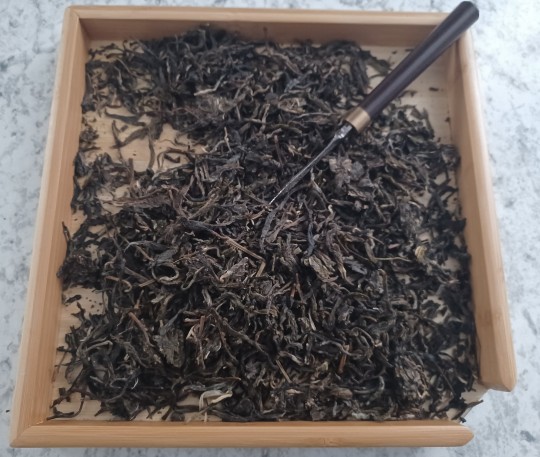
In this final part of the experiment we look into the theory of aging Puerh loose. Some argue that the only way to perfect age Puerh is to age a mao cha (loose tea) either by buying it loose or breaking your cakes up and storing the loose leaves.
Cake #4 was completely broken and divided evenly into thirds.

One third was placed in a small ceramic jar with a loose fitting lid that allows for controlled oxygen flow. One third was placed in a ziplock bag with all the oxygen pressed out of it. And finally one third was placed in a simple brown paper bag to simulate being store in it’s wrapper. Here I hope to see how the tea ages loose and how well it can be preserved loose.
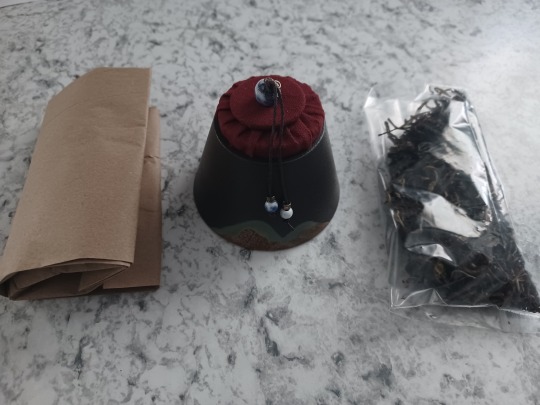
Cake #5 is being used for drinking now in order to create tasting notes and take photos for documentation and comparison tastings after the experiment is complete. This experiment will run exactly one year starting Sunday April 17th 2022 - April 17th 2023. Until then the Puerh is all being stored in the same area of the house where temperature and humidity tend to naturally fluctuate in small amounts throughout the year, aka the tea room.

In one year’s time I will be opening all these teas up again to due multiple side by side comparison tastings. Stay tuned for initial tasting notes from cake #5.
#tea#loosetea#teablr#puerh#puerhtea#yunnan#china#chinatea#yunnantea#science#storaged#aging#agingtea#stoaringtea#teaexperiment#experiment.#pig#golden#goldenpig#puerhcake#taecake
18 notes
·
View notes
Photo
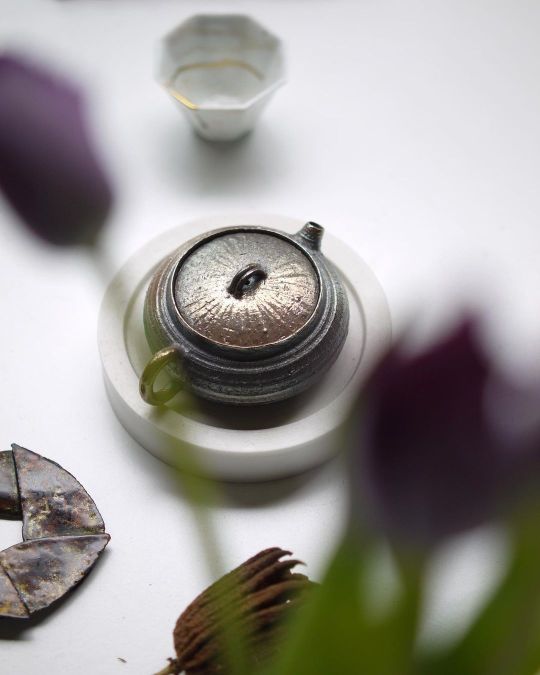
Frankly, I like this teapot. . . . #pottery #ceramics #artwork #woodfiredceramics #handbuilding #wabisabistyle #wabisabiart #ceramitist #ceramitique #bestceramics #dehua #chinatea #teaislife https://www.instagram.com/p/ClygdZNOFAD/?igshid=NGJjMDIxMWI=
#pottery#ceramics#artwork#woodfiredceramics#handbuilding#wabisabistyle#wabisabiart#ceramitist#ceramitique#bestceramics#dehua#chinatea#teaislife
0 notes
Photo

2022年期待已久的古樹好茶,已順利就位。 生普的生命力,在壓製成型後,開始積極穩健,日積月累完成獨特的口感,正是這樣的轉化,賦予了收藏的價值. #2022年 #古樹茶 #荒山 #春茶 #白鶯山 #茶葉 #普洱茶 #生普洱 #普洱生茶 #云南普洱 #毛茶 #茶 #茶禪一味 #中国茶 #茶文化 #chinatea #yunnantea #tea #tealeaf #tealover #teastagram #shengpuer #puer #puerh #teatime #puretea #puertea #teatimes #teagift #tealifestyle https://www.instagram.com/p/ChJTPN8rlbb/?igshid=NGJjMDIxMWI=
#2022年#古樹茶#荒山#春茶#白鶯山#茶葉#普洱茶#生普洱#普洱生茶#云南普洱#毛茶#茶#茶禪一味#中国茶#茶文化#chinatea#yunnantea#tea#tealeaf#tealover#teastagram#shengpuer#puer#puerh#teatime#puretea#puertea#teatimes#teagift#tealifestyle
0 notes